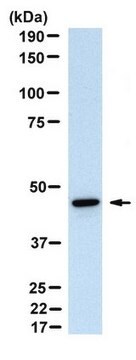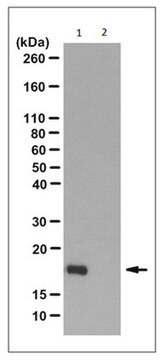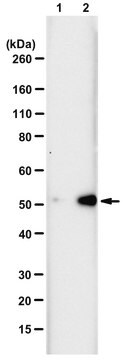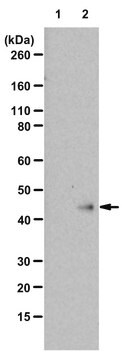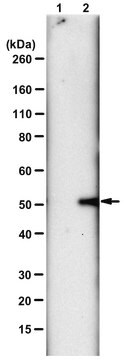MABS1330
Anti-N1-Phosphohistidine (1-pHis) Antibody, clone SC1-1
clone SC1-1, from rabbit
Synonim(y):
N1-Phosphohistidine
About This Item
Polecane produkty
pochodzenie biologiczne
rabbit
Poziom jakości
forma przeciwciała
purified antibody
rodzaj przeciwciała
primary antibodies
klon
SC1-1, monoclonal
reaktywność gatunkowa
E. coli, human
reaktywność gatunkowa (przewidywana na podstawie homologii)
all
metody
affinity chromatography: suitable
dot blot: suitable
immunocytochemistry: suitable
western blot: suitable
izotyp
IgG
Warunki transportu
wet ice
docelowa modyfikacja potranslacyjna
phosphorylation (N1-pHis)
Opis ogólny
Specyficzność
Immunogen
Zastosowanie
Western Blotting Analysis: A representative lot detected heat-sensitive histidine N1-phosphorylation (1-pHis) in multiple cell lysates (Fuhs, S.R., et al. (2015). Cell. 162(1):198-210).
Immunocytochemistry Analysis: A representative lot detected N1-phosphohistidine (1-pHis) immunoreactivity distinct from that of 3-pHis in 4% paraformaldehyde-fixed HeLa cells and murine bone marrow-derived macrophages by fluorescent immunocytochemistry. The 1-pHis immunoreactivity was found in regions surrounding acidic compartments, but not inside these compartments or nuclei (Fuhs, S.R., et al. (2015). Cell. 162(1):198-210).
Immunoaffinity Purification: A representative lot was cross-linked to protein A resins for immunoaffinity purification of 1-pHis proteins from cell lysates prior to LC-MS/MS analysis (Fuhs, S.R., et al. (2015). Cell. 162(1):198-210).
Note: DO NOT HEAT SAMPLES prior to phosphohistidine detection. Histidine phosphorylation is heat and acid labile. To generate negative control for specificity test, an aliquot of sample can be heated at 95ºC for 10-15 minutes to reverse histidine phosphorylation. Alternatively, an aliquot of sample can be incubated under acidified pH at 37ºC for 15 minutes to reduce histidine phosphorylation. Acidify each 100 µL sample with 25 µL of 1 M HCl before the incubation, then neutralize with 25 µL of 1 M NaOH prior to phosphohistidine detection.
Jakość
Western Blotting Analysis: 0.3 µg/mL of this antibody detected recombinant human NME1 (NM23-H1) with N1-phosphohistidine (1-pHis) in a 5 µg aliquot of autophosphorylation reaction.
Opis wartości docelowych
Postać fizyczna
Inne uwagi
Nie możesz znaleźć właściwego produktu?
Wypróbuj nasz Narzędzie selektora produktów.
Kod klasy składowania
12 - Non Combustible Liquids
Klasa zagrożenia wodnego (WGK)
WGK 1
Temperatura zapłonu (°F)
Not applicable
Temperatura zapłonu (°C)
Not applicable
Certyfikaty analizy (CoA)
Poszukaj Certyfikaty analizy (CoA), wpisując numer partii/serii produktów. Numery serii i partii można znaleźć na etykiecie produktu po słowach „seria” lub „partia”.
Masz już ten produkt?
Dokumenty związane z niedawno zakupionymi produktami zostały zamieszczone w Bibliotece dokumentów.
Nasz zespół naukowców ma doświadczenie we wszystkich obszarach badań, w tym w naukach przyrodniczych, materiałoznawstwie, syntezie chemicznej, chromatografii, analityce i wielu innych dziedzinach.
Skontaktuj się z zespołem ds. pomocy technicznej
